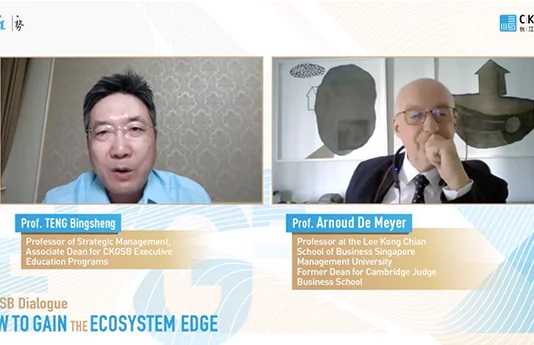Corporate life after the departure of charismatic leaders.
Walt Disney. Steve Jobs. Henry Ford–as Charles de Gaulle said, the cemeteries are full of indispensible men. But sooner or later, all companies with a charismatic CEO must find a way to manage without them.
Charismatic leaders can be a gift or a calamity for an organization, and often a mixture of both. In any case, once Elvis has left the building, companies that have built themselves around an outsized personality may struggle for years to find a new equilibrium.
Hero to Zero
Not all charismatic leaders leave chaos in their wake. David Waldman, a professor of management at the W.P. Carey School of Business at Arizona State University in Tempe, makes a distinction between generative charismatics and personalized charismatics. The generative individual leaves behind an organization that can continue growing, while the personalized charismatic will leave behind a largely leadersless and dysfunctional company. Waldman argues that in his first tenure at Apple, Steve Jobs was a personalized charismatic, and the organization floundered when he was forced out. But leaders can change, and in the case of Jobs, he had matured into the generative type in his second tenure, and was able to leave a solid organization behind when he died in 2011.
Such personalized or narcissistic charismatics tend to be a mixed blessing. In fact, superstar CEOs often bring more pain than gain. One 2009 Berkeley study has shown that even an award-winning CEO may not be much of a bargain. Winning a major award can be a great thing for the CEO: the year following a major award, the compensation of the high-flying chief goes up an average of 44% although they’re actually working somewhat less on their day job. However, it’s not so good for the company: the winning company’s stock price typically falls 15-26% over the three years that follow the award, according to the study.
This isn’t an anomaly, experts say. “They are more likely to do whatever is going to make them look good at the moment… rather than taking actions designed to truly grow the organization so that 10 years later it will be a thriving, successful business,” says Roy Lubit, a New York-based psychiatrist and executive coach and author of Coping with Toxic Managers.
But even more damaging than what they do to short-term performance is the long-term impact a narcissistic CEO can have on her organization. The intent might be to build a company that’s insanely great, but the results are more often simply insane. One case in point: between 1999 and 2005, under the leadership of Carly Fiorina, Hewlett-Packard’s stock price dropped by half–and nearly 10 years later has suffered repeated peaks and troughs and is still about 40% of what it was in 1999.
Just as children grow up “learning not to push certain buttons”, but will misbehave in ways their parents don’t mind that much, employees will model their behavior on what’s allowed in the organization, says Timothy Quigley, an assistant professor of management at the Terry College of Business at the University of Georgia in Athens, Georgia.
“Leaders have an incredible impact on their culture, based on how they behave. If people see a leader being ruthless with other employees, or being self-centered, many workers will say to themselves, this is the way things are done here, this is the culture,” Lubit says.
Occasionally, the charismatic can create a culture so toxic that it doesn’t even outlast him–Enron, for example, didn’t survive the departure of CEO Ken Lay, nor did Lehman Brothers outlast Dick Fuld.
Often, the pressure a narcissist puts on the people around her can have a number of negative effects. In the short run, pressure from a narcissistic CEO can lead to serious stress-related health problems for many in upper management, especially during a downturn, when there are few other options. In the past five years, says Carol Kivler, a New Jersey-based executive coach, she has seen many employees of such companies “burnt out or found themselves visiting hospital emergency rooms frequently only to be told their symptoms were stress-related,” she says.
They can also damage the culture permanently. “Narcissistic leaders steal credit from subordinates damaging morale. They do not put in the time and effort needed to help subordinates develop,” Lubit says.
The most extreme narcissists, the personalized charismatics, usually hate to have their opinions called into question, and to guard against embarrassment, they will sometimes surround themselves with people whose most conspicuous talent is an ability to curry favor with the boss. “I think that the personalized charismatics pick people who will be yes men and yes women who will do their bidding but not really grow as leaders themselves,” Waldman says.
People with independent opinions get the message and eventually, the company is left with second-rate managers. “The good people with leader-like qualities end up leaving over time,” Waldman explains.
Extreme narcissists will also shape the culture in other ways as well. “They’re Machiavellian. One of the ways that they manipulate things is that they try to manipulate information–the meaning of information as well as who has access to it,” Waldman says.
For similar reasons, ethics and accountability may be more of a problem too. Psychologists have noted that narcissists tend to have more difficulty facing unpleasant realities than other people, and in hard times, this can lead them to take more ethical chances and a tendency to deflect blame if something goes wrong.
Not surprisingly, such companies tend to be top-down organizations, and the people at the bottom are frequently disengaged. “They do their jobs as best they can but are somewhat disengaged and noncommittal to the organization,” Waldman says.
Turning the culture around
The leader who steps into a charismatic CEO’s blue suede shoes faces a number of challenges, management experts say. “It’s not just this void of the CEO, it’s a void of all these other roles that this one person played,” says Quigley. The new CEO won’t have all the skills or the informal networks the departing person may have developed over decades. “It’s almost an impossible task,” he says.
For the successor, it’s important to act quickly. Often, the successor will enjoy an initial honeymoon period, says Waldman, and he or she needs to take advantage of it. “This phenomenon probably sounds pretty familiar in terms of the current political stage, but it is also likely to happen in industry, he adds.
Management experts say the successor of a charismatic CEO faces three major challenges.
The first is to communicate to employees about his own values and his own vision. Michael Maccoby, a Washington, D.C.-based psychoanalyst who specializes in leadership issues, and author of The Productive Narcissist, says that he advised a CEO who had just taken over from a charismatic CEO that he needed to tell employees what he stood for right away. “That improved very much how they saw him… He could then emphasize his values of learning and collaboration and ethics that really were not so much encouraged with the charismatic leader,” he recalls.
This kind of performance may not be easy, as the heir is often not a visionary but a solid operating officer whose role had been not so much to inspire the organization as to make sure it could deliver on the chief’s promises. “Most charismatic leaders need a Number Two person who really is able to make sure that the ideas get implemented. It’s natural when the charismatic leader leaves that this Number Two person becomes the CEO. But that kind of person is not going to be very charismatic or visionary,” says Maccoby.
Second, if he is taking over from a very successful charismatic, the new CEO will need to find ways to fill some of the gaps left by the predecessor. In Apple, for example, CEO Tim Cook’s challenge appears to be not managing operations—he did that for years while Jobs was alive—as to find ways to compensate for the loss of Jobs’ creativity, Waldman says.
But the final challenge raised may be the most important: make the organization a better place to work. Particularly if the economy is in recovery, such companies need to find ways to retain employees who previously put up with bullying because they lacked other options, and to rebrand themselves to attract top graduates, Kivler says.
In a way, the new CEO must help the organization gain a new level of maturity. Rather than wait for the great leader to decide, they need to develop processes that compensate for what the former CEO brought to the table. “In a sense you can say, the whole organization has to mature, has to grow up, and the new leader has to be the person who helps them do that,” Maccoby says.




















